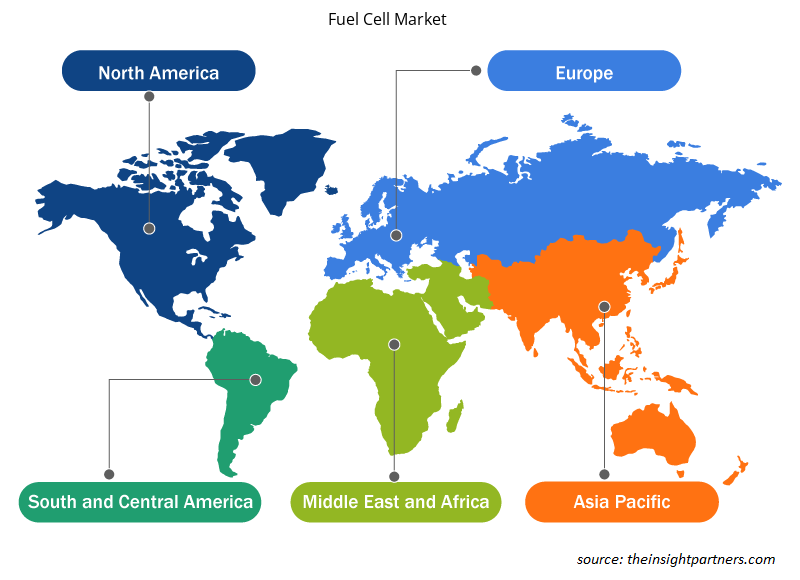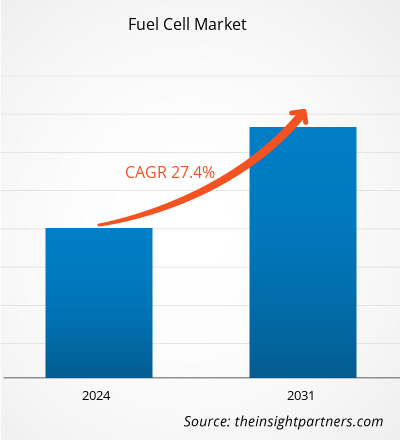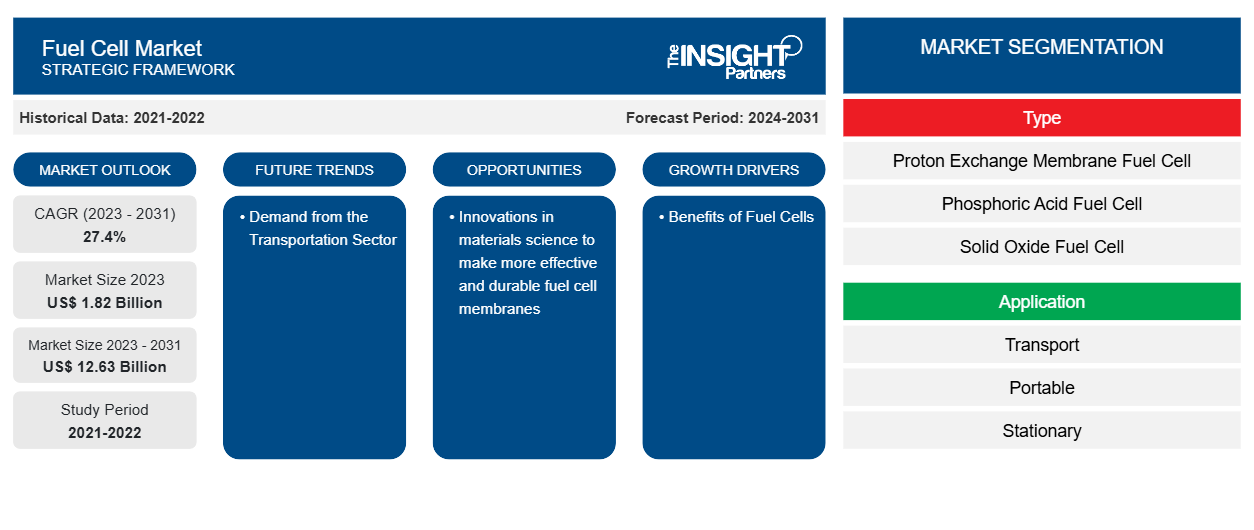Si prevede che la dimensione del mercato delle celle a combustibile raggiungerà i 12,63 miliardi di dollari entro il 2031, rispetto agli 1,82 miliardi di dollari del 2023. Si prevede che il mercato registrerà un CAGR del 27,4% nel 2023-2031. I vantaggi delle celle a combustibile rispetto alle tecnologie tradizionali basate sulla combustione e la crescente domanda di fonti energetiche non convenzionali rimarranno probabilmente fondamentali per le tendenze del mercato delle celle a combustibile.
Analisi del mercato delle celle a combustibile
La crescente domanda dei consumatori per fonti energetiche non convenzionali è uno dei principali fattori trainanti. Per ridurre l'impatto ambientale si prevede che alimenterà la domanda di tecnologie a celle a combustibile. Si prevede che i governi di tutto il mondo integreranno questi progressi con supporto in varie forme, come il finanziamento di iniziative di ricerca e sviluppo e appropriati schemi di finanziamento. Inoltre, le iniziative e gli investimenti governativi per promuovere il mercato dei veicoli elettrici rafforzano ulteriormente la crescita del mercato.
Panoramica del mercato delle celle a combustibile
Una cella a combustibile genera elettricità in modo efficace e pulito sfruttando l'energia chimica dell'idrogeno o di altri combustibili. Gli unici sottoprodotti, se l'idrogeno è il combustibile, sono calore, acqua ed elettricità. La gamma di potenziali utilizzi delle celle a combustibile le rende uniche; possono alimentare sistemi grandi come centrali elettriche di pubblica utilità e piccoli come computer portatili, utilizzando una varietà di combustibili e materie prime.
Personalizza questo report in base alle tue esigenze
Riceverai la personalizzazione gratuita di qualsiasi report, comprese parti di questo report, o analisi a livello nazionale, pacchetto dati Excel, oltre a usufruire di grandi offerte e sconti per start-up e università
-
Scopri le principali tendenze di mercato in questo rapporto.Questo campione GRATUITO includerà analisi di dati che spaziano dalle tendenze di mercato alle stime e alle previsioni.
Driver e opportunità del mercato delle celle a combustibile
Vantaggi delle celle a combustibile per favorire il mercato
Le celle a combustibile possono essere utilizzate per alimentare una varietà di applicazioni, tra cui trasporti, edifici industriali/commerciali/residenziali e stoccaggio di energia di rete a lungo termine in sistemi reversibili. Le celle a combustibile presentano numerosi vantaggi rispetto alle tradizionali tecnologie basate sulla combustione. Inoltre, vengono utilizzate in varie centrali elettriche e veicoli. Possono funzionare a efficienze più elevate rispetto ai motori a combustione, convertendo l'energia chimica nel combustibile direttamente in energia elettrica con efficienze superiori al 60%. Rispetto ai motori a combustione , le celle a combustibile emettono meno o nessuna emissione. Le celle a combustibile a idrogeno emettono solo acqua, affrontando le sfide climatiche critiche senza emissioni di anidride carbonica. Non ci sono inoltre inquinanti atmosferici che causano smog o problemi di salute nel punto di funzionamento. Le celle a combustibile sono silenziose da utilizzare perché hanno poche parti mobili.
Domanda dal settore dei trasporti
Il mercato delle celle a combustibile è un settore in rapida espansione e offre molte diverse opportunità commerciali. La tecnologia è in continua evoluzione e nuovi design e materiali si traducono in prestazioni ed efficienza più elevate. Di conseguenza, le celle a combustibile stanno diventando più interessanti per una più ampia varietà di utilizzi. Il mercato delle celle a combustibile è uno dei più grandi nel settore dei trasporti. Rispetto ai veicoli elettrici a batteria (BEV), i veicoli elettrici a celle a combustibile (FCEV) presentano una serie di vantaggi, tra cui una maggiore autonomia e tempi di rifornimento più rapidi. Si prevede che i veicoli a celle a combustibile vedranno una rapida crescita della quota di mercato man mano che il costo degli FCEV diminuisce e l'infrastruttura dell'idrogeno si espande. Varie iniziative del governo per rafforzare il mercato dei veicoli elettrici nei prossimi anni possono creare un'enorme opportunità per la crescita del mercato delle celle a combustibile.BEVs), fuel cell FCEVs) have a number of benefits, including a greater range and quicker refueling times. Fuel cell vehicles are predicted to see rapid growth in market share as the cost of FCEVs decreases and the hydrogen infrastructure expands. Various initiatives by the government to bolster the electric vehicles market in the coming years can create a huge opportunity for the fuel cell market growth.
Analisi della segmentazione del rapporto di mercato delle celle a combustibile
I segmenti chiave che hanno contribuito alla derivazione dell'analisi di mercato delle celle a combustibile sono tipologia, applicazione e utente finale.
- In base al tipo, il mercato è segmentato in celle a combustibile a membrana a scambio protonico (PEMFC), celle a combustibile ad acido fosforico (PAFC), celle a combustibile a ossidi solidi (SOFC) e altre. Il segmento delle celle a combustibile a membrana a scambio protonico (PEMFC) ha detenuto una quota di mercato maggiore nel 2023.
- Per applicazione, il mercato è segmentato in trasporto, portatile e stazionario. Il segmento stazionario ha detenuto una quota di mercato maggiore nel 2023.
- In base all'utente finale, il mercato è segmentato in veicoli a celle a combustibile, servizi di pubblica utilità, difesa e altri. Il segmento dei servizi di pubblica utilità ha detenuto una quota di mercato maggiore nel 2023.
Analisi della quota di mercato delle celle a combustibile per area geografica
L'ambito geografico del rapporto sul mercato delle celle a combustibile è suddiviso principalmente in cinque regioni: Nord America, Asia Pacifico, Europa, Medio Oriente e Africa e Sud America/Sud e Centro America.
In termini di fatturato, l'Asia Pacifica ha rappresentato la quota di mercato più grande delle celle a combustibile nel 2023. Case automobilistiche come Yamaha, Toyota e altre stanno adottando misure per incoraggiare le tecnologie delle celle a combustibile, il che sta portando alla crescita del mercato delle celle a combustibile nell'Asia Pacifica. Ad esempio, a gennaio 2023, in linea con la sua missione di "Produrre felicità per tutti", che cerca di contribuire a stabilire una società sostenibile "a prova di futuro" che sia in armonia con la natura, Toyota ha sviluppato tecnologie verdi e pulite che promuovono la sostenibilità in tutte le regioni. Essendo pionieri nelle tecnologie dei veicoli elettrificati e di altri veicoli verdi, l'azienda si impegna a offrire una gamma di veicoli elettrificati e a combustibile alternativo per ridurre al minimo le emissioni di CO2 prendendo in considerazione la generazione di energia, la prontezza delle infrastrutture e l'adozione da parte dei consumatori di ciascun paese/regione. Inoltre, a livello globale Toyota si impegna a raggiungere la neutralità carbonica entro il 2050 e mira a raggiungere Net Carbon Zero nelle operazioni di produzione entro il 2035.
Approfondimenti regionali sul mercato delle celle a combustibile
Le tendenze regionali e i fattori che influenzano il mercato delle celle a combustibile durante il periodo di previsione sono stati ampiamente spiegati dagli analisti di Insight Partners. Questa sezione discute anche i segmenti e la geografia del mercato delle celle a combustibile in Nord America, Europa, Asia Pacifico, Medio Oriente e Africa e Sud e Centro America.

- Ottieni i dati specifici regionali per il mercato delle celle a combustibile
Ambito del rapporto sul mercato delle celle a combustibile
| Attributo del report | Dettagli |
|---|---|
| Dimensioni del mercato nel 2023 | 1,82 miliardi di dollari USA |
| Dimensioni del mercato entro il 2031 | 12,63 miliardi di dollari USA |
| CAGR globale (2023-2031) | 27,4% |
| Dati storici | 2021-2022 |
| Periodo di previsione | 2024-2031 |
| Segmenti coperti |
Per tipo
|
| Regioni e Paesi coperti |
America del Nord
|
| Leader di mercato e profili aziendali chiave |
|
Densità degli attori del mercato delle celle a combustibile: comprendere il suo impatto sulle dinamiche aziendali
Il mercato delle celle a combustibile sta crescendo rapidamente, spinto dalla crescente domanda degli utenti finali dovuta a fattori quali l'evoluzione delle preferenze dei consumatori, i progressi tecnologici e una maggiore consapevolezza dei vantaggi del prodotto. Con l'aumento della domanda, le aziende stanno ampliando le loro offerte, innovando per soddisfare le esigenze dei consumatori e capitalizzando sulle tendenze emergenti, il che alimenta ulteriormente la crescita del mercato.
La densità degli operatori di mercato si riferisce alla distribuzione di aziende o società che operano in un particolare mercato o settore. Indica quanti concorrenti (operatori di mercato) sono presenti in un dato spazio di mercato in relazione alle sue dimensioni o al valore di mercato totale.
Le principali aziende che operano nel mercato delle celle a combustibile sono:
- Società per azioni Cummins Inc.
- Energia FuelCeIl, Inc.
- Società di fornitura di energia elettrica
- Energia di fioritura
- Sistemi di alimentazione Ballard
- SFC Energia AG
Disclaimer : le aziende elencate sopra non sono classificate secondo un ordine particolare.

- Ottieni una panoramica dei principali attori del mercato delle celle a combustibile
Notizie e sviluppi recenti sul mercato delle celle a combustibile
Il mercato delle celle a combustibile viene valutato raccogliendo dati qualitativi e quantitativi dopo la ricerca primaria e secondaria, che include importanti pubblicazioni aziendali, dati associativi e database. Di seguito è riportato un elenco degli sviluppi nel mercato:
- Nel settembre 2023, in un passo significativo verso la mobilità verde, il Ministro dell'Unione indiana per il petrolio e il gas naturale e per l'edilizia abitativa e gli affari urbani ha inaugurato il primo autobus a celle a combustibile a idrogeno verde a Kartavya Path a Delhi. (Fonte: Ministero del petrolio e del gas naturale, comunicato stampa, 2023)
- Nel marzo 2024, Hyzon (NASDAQ: HYZN), azienda leader negli Stati Uniti nello sviluppo di tecnologie per celle a combustibile a idrogeno e fornitore globale di veicoli elettrici a celle a combustibile (FCEV) per impieghi pesanti a zero emissioni, ha lanciato il suo sistema a celle a combustibile da 200 kW a pila singola e il gruppo propulsore in un veicolo durante una cerimonia a cui hanno partecipato funzionari governativi, operatori di flotte di veicoli pesanti, dipendenti e dirigenti aziendali. (Fonte: PR Newswire, comunicato stampa, 2024)
- Nel gennaio 2024, l'ISRO ha testato con successo un sistema di alimentazione basato su celle a combustibile a membrana elettrolitica polimerica (FCPS) da 100 W nella sua piattaforma orbitale, POEM3, lanciata a bordo del PSLV-C58 il 1° gennaio 2024. L'obiettivo dell'esperimento era valutare il funzionamento delle celle a combustibile a membrana elettrolitica polimerica nello spazio e raccogliere dati per facilitare la progettazione di sistemi per missioni future. Durante il test di breve durata a bordo del POEM, è stata generata una potenza di 180 W da gas idrogeno e ossigeno immagazzinati a bordo in recipienti ad alta pressione. Ha fornito una grande quantità di dati sulle prestazioni di vari sistemi statici e dinamici che facevano parte del sistema di alimentazione e sulla fisica in gioco. (Fonte: ISRO, comunicato stampa, 2024)
Copertura e risultati del rapporto sul mercato delle celle a combustibile
Il rapporto “Dimensioni e previsioni del mercato delle celle a combustibile (2021-2031)” fornisce un’analisi dettagliata del mercato che copre le seguenti aree:
- Dimensioni e previsioni del mercato a livello globale, regionale e nazionale per tutti i segmenti di mercato chiave coperti dall'ambito
- Dinamiche di mercato come fattori trainanti, vincoli e opportunità chiave
- Principali tendenze future
- Analisi dettagliata delle cinque forze PEST/Porter e SWOT
- Analisi di mercato globale e regionale che copre le principali tendenze di mercato, i principali attori, le normative e gli sviluppi recenti del mercato
- Analisi del panorama industriale e della concorrenza che copre la concentrazione del mercato, l'analisi della mappa di calore, i principali attori e gli sviluppi recenti
- Profili aziendali dettagliati
- Analisi storica (2 anni), anno base, previsione (7 anni) con CAGR
- Analisi PEST e SWOT
- Valore/volume delle dimensioni del mercato - Globale, Regionale, Nazionale
- Industria e panorama competitivo
- Set di dati Excel
Report recenti
Rapporti correlati
Testimonianze
Motivo dell'acquisto
- Processo decisionale informato
- Comprensione delle dinamiche di mercato
- Analisi competitiva
- Analisi dei clienti
- Previsioni di mercato
- Mitigazione del rischio
- Pianificazione strategica
- Giustificazione degli investimenti
- Identificazione dei mercati emergenti
- Miglioramento delle strategie di marketing
- Aumento dell'efficienza operativa
- Allineamento alle tendenze normative























 Ottieni un campione gratuito per - Mercato delle celle a combustibile
Ottieni un campione gratuito per - Mercato delle celle a combustibile